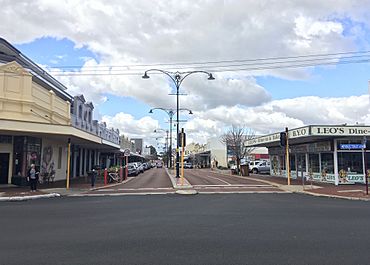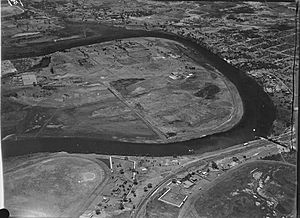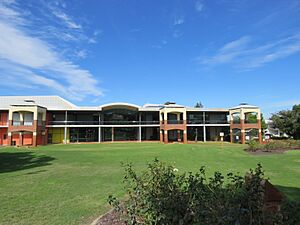Maylands, Western Australia facts for kids
Quick facts for kids MaylandsPerth, Western Australia |
|||||||||||||||
|---|---|---|---|---|---|---|---|---|---|---|---|---|---|---|---|

Looking south down Eighth Avenue from Maylands railway station
|
|||||||||||||||
| Established | 1830s | ||||||||||||||
| Postcode(s) | 6051 | ||||||||||||||
| Area | 5 km2 (1.9 sq mi) | ||||||||||||||
| Location | 5 km (3 mi) NE of the Perth CBD | ||||||||||||||
| LGA(s) | City of Bayswater | ||||||||||||||
| State electorate(s) | Maylands | ||||||||||||||
| Federal Division(s) | Perth | ||||||||||||||
|
|||||||||||||||
Maylands is a lively suburb located near the Swan River in Perth, Western Australia. It's about 4.5 kilometres (2.8 miles) northeast of Perth's city centre. The suburb is built around the Midland and High Wycombe railway lines.
Maylands started growing in the 1890s. It's part of the City of Bayswater local government area. The suburb is next to Mount Lawley, East Perth, and Bayswater. Maylands railway station makes it easy to travel to the city and other places. The railway line was first built in the 1880s. The station was updated in 2000. There's also a path for bikes and walkers along the Swan River. This path connects Maylands to nearby suburbs. You can also find a small yacht club and a golf course here.
Long ago, Maylands was known for its clay. This clay was used to make bricks and tiles at the Maylands Brickworks. The old clay pits are now part of a golf course and homes. Maylands was also home to Perth's main airport until the early 1960s. This airport handled many types of planes, even flying boats! Later, the airport moved to Perth Airport. The old airport buildings then became a training area for the Western Australian Police.
Contents
Maylands: A Look at Its Past
The name "Maylands" first appeared in 1896. It was on a poster advertising land for sale. But how the area got its name is still a bit of a mystery! One idea is that Mephan Ferguson, who owned a local factory, named it after his aunt and daughter, both called May. Another idea is that Edgar W. Hamer named it. He worked for Golds Estates of Australia. He might have named it after inspecting the land in May.
The Historic Peninsula Hotel
The Peninsula Hotel is a famous building in Maylands. It's located on Railway Parade. The hotel was built in 1906. A well-known builder named Friederich Wilhelm Gustave Liebe constructed it.
Maylands' Old Airport: A Hub of Early Aviation
The Maylands Aerodrome was built to support West Australian Airways Ltd. This company ran Australia's first commercial air service. This was even before Qantas!
Maylands Airport is famous for a special landing. Charles Kingsford Smith landed here after the first non-stop flight across Australia. On August 8, 1928, his plane, the "Southern Cross," took off from Point Cook near Melbourne. It flew over 3,200 kilometres (2,000 miles) to Perth. The flight was tough, with cold weather and thick clouds. They even drifted off course to Bunbury, 180 kilometres (110 miles) south. When they arrived at Maylands, the airport field was very wet from summer rains.
Maylands Airport During World War II
During World War II, the Royal Australian Air Force (RAAF) took over Maylands Airfield. From February 1942, the United States Army Air Forces also used it. They refuelled planes and moved them to other places. Between April 1942 and August 1943, No. 35 Squadron was based at Maylands. They flew Avro Anson planes. Their job was to carry supplies and people to Allied units across Western Australia. They also helped the Royal Australian Navy and the Australian Army.
Maylands Today: A Revitalised Community
In December 2009, the City of Bayswater approved a plan for the Maylands town centre. This plan was made after talking to many people in the community. It guides how the town centre will grow and improve.
In recent years, Maylands has become much more vibrant. Many new buildings and businesses have opened. This has brought new people and energy to the town centre. New bars, cafes, and restaurants have opened. There are also gourmet food shops and other retail stores. All these changes have made Maylands a lively and welcoming place.
Maylands is also becoming a centre for culture and art. The Western Australian Ballet moved here in 2012. They are in the old Western Australian Institute for the Blind building. Places like Estudio Nuevo, Studio 281, and Swallow Bar offer music, dance, and art. The Maylands Hawkers Markets also provide great food and cultural experiences. These places show Maylands' unique creative spirit.
Culture and Arts in Maylands
Western Australian Ballet: A Home for Dance
The West Australian Ballet Centre is in Maylands. It's on the historic site of the former Blind Institute. The building's history goes back to 1897. It was first called the Victoria Institute and the Industrial School for the Blind. This was part of the celebrations for Queen Victoria’s 60th year as queen.
This beautiful building is a symbol of Perth's history. It has high ceilings, wooden floors, and a classic charm. It's a perfect place for the West Australian Ballet. The building helps the artistic team create amazing, world-class dance shows.
Lyric Lane: A New Music Venue
The Council recently approved the Lyric Lane Bar and Café. This new place has a bar, a cafe, and a live music basement. It offers new cultural activities in the town centre. The project is now open for everyone to enjoy.
WA Youth Jazz Orchestra: Music for Young Talent
It has been announced that the Western Australian Youth Jazz Orchestra will soon move to Maylands. They will be in the old Maylands Hall. This hall is at the corner of Eighth Avenue and Guildford Road.
Community Life in Maylands
Community Groups: Working Together
Many community groups help make Maylands a great place. These include Creative Maylands and Local Arts and Community Events Inc (LACE). There's also the Maylands Residents and Ratepayers Association. The Maylands Historical and Peninsula Association (Inc) and Maylands Business Association are also active. These groups are made up of passionate people. They work to make sure Maylands' values are kept for the future.
Local Arts and Community Events Inc (LACE)
LACE is a non-profit group. They organise the Maylands Hawker Markets. They also now organise the Maylands Street Festival. LACE aims to create free, welcoming community events. These events help bring people together.
Creative Maylands: Connecting People and Ideas
Since October 2010, Creative Maylands has been busy. They manage and support activities that make Maylands more creative. Their goal is to connect people and ideas. This helps make Maylands a wonderful place to live, work, and visit.
Maylands Business Association: Supporting Local Businesses
This group has many local businesses working together. They want to improve Maylands. They aim to make it a popular place for the community. They also promote the interests of local businesses. The group works with the Council and State Government. They help shape policies that match their vision for Maylands.
Maylands Historical Society: Preserving the Past
The Maylands Historical Society started in October 1992. It was formed at a public meeting in the Maylands Library. The Maylands Ratepayers and Residents Association helped start it. The Mayor of the City of Stirling officially named it the Maylands Historical Society. By June 2003, its name changed to Maylands Historical and Peninsula Association.
Community Facilities: Places to Learn and Play
RISE: A Modern Community Hub
The City of Bayswater's RISE centre opened in July 2011. RISE stands for Recreation, Information, Socialising and Entertainment. It replaced the older Alma Venville Centre. RISE is a large, modern community centre. It has a library, a gym, a cafe, and a creche. It also has sports courts, function rooms, meeting rooms, and a community hall.
Maylands Yacht Club: Sailing on the Swan River
The Maylands Yacht Club is located on the Swan River. It's on the Maylands foreshore. The MYC is a club for families. They focus on having fun and helping people learn to sail. The club sails many types of boats. These include single-person boats like Laser and Sabre. They also have two-person dinghies like Mirrors.
Maylands Tennis Club: Enjoying the Courts
The Maylands Tennis Club is a special grass court club. It's in a quiet spot on the Maylands Peninsula. It overlooks the Swan River. The club is open all year. It has 14 grass courts and 3 hard courts. In winter, four grass courts are still open. The club offers tennis for all skill levels. It's also known for its fun social events all year round.
Maylands Cricket Club: Summer Sports
The Maylands Cricket Club plays at De Lacy Reserve. It's a small community club that plays during the summer months. It started in 1958/59 as the Peninsula Cricket Club. In the 1970s, it became the Maylands Peninsula Cricket Club. Finally, in 1989, it was named the Maylands Cricket Club.
Maylands Population: Who Lives Here?
In 2016, Maylands had a population of 12,577 people. This was an increase from previous years. About 51.2% of residents are male, and 48.8% are female. The average age in Maylands is 34. This is younger than the average for Western Australia. About 38.0% of residents over 15 are married.
Maylands has 6,908 homes. Most of these homes (5,647) were lived in. Of the occupied homes, 1,742 were detached houses. There were also 1,948 semi-detached homes and 1,936 apartments or flats. The number of apartments (34.3%) is much higher than the state average. Many homes in Maylands are rented (49.2%). This is also higher than the state average.
The average weekly income for a household in Maylands was $1,449. This is a bit lower than the state average. People in Maylands work in many different jobs. Some common industries are hospitals, cafes and restaurants, and state government.
Most people in Maylands were born in Australia (49.8%). However, this is lower than the state average. Other common birthplaces include India (6.5%), England (6.1%), and New Zealand (2.4%). Many residents (51.1%) have parents who were not born in Australia. When it comes to religion, many people said they had no religion (35.8%). Other popular religions include Catholic (19.9%) and Anglican (7.9%).
Education in Maylands
The only school in Maylands is Maylands Peninsula Primary School. This is a public primary school. It has about 670 students from Kindergarten to Year 6. It opened in 2004. It was formed by combining Maylands Primary School and East Maylands Primary School. Maylands Primary School was the first school in the area, opening in 1903. East Maylands Primary School started in 1954. The old Maylands Primary School site is now used by the Constable Care Safety School.
There are no high schools in Maylands itself. But students in Maylands can go to John Forrest Secondary College or Mount Lawley Senior High School.
Maylands is also home to the Western Australian Department of Education's Instrumental Music School Services. This service helps public schools in Western Australia. They provide music teachers, lesson plans, and instruments. They help schools offer music lessons to students.
Getting Around Maylands: Transport Options
Bus Services
- Route 40: Travels from Elizabeth Quay Bus Station to Morley Bus Station. It uses Guildford Road.
- Route 41: Goes from Elizabeth Quay Bus Station to Bayswater Station. It uses Guildford Road, Eighth Avenue, East Street, Caledonian Avenue, and Stone Street.
- Route 42: Connects Elizabeth Quay Bus Station to Maylands Boat Ramp. It uses Guildford Road, Eighth Avenue, Peninsula Road, Tranby Road, and Clarkson Road.
- Route 43: Travels from Elizabeth Quay Bus Station to Maylands Boat Ramp. It uses Guildford Road, Central Avenue, East Street, Peninsula Road, Tranby Road, and Clarkson Road.
Train Services
- Midland/Airport Line: You can catch trains on the Midland and Airport Line.
- Maylands Station: This is the main train station in Maylands.
Images for kids







